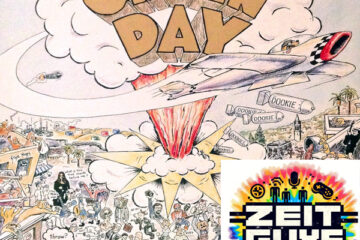Action Philosophers by Fred Van Lente (Author), Ryan Dunlavey (Author) is an omnibus of comic histories of philosophy and philosophers. For copyright reasons, we cannot share the comics, but have the license for the class. In the meantime, I recommend the book highly. The students read the chapters on Thomas Hobbes and Thomas Jefferson.
Action Philosophers- Thomas Jefferson Fred Van Lente and Ryan Dunleavey 2006 by Bridget Durham
“The man drafted to draft this declaration was the quiet delegate in congress– a man whose own speaking voice barely rose above a whisper–but was unanimously agreed to be the greatest action political writer in the country,” Thomas Jefferson. Jefferson was a calm headed individual, which is showed by the art of the comic, and was the only one that was suitable to write the Declaration of Independence. His writing was so influential to the point where the author referred to it as “American scripture.” “American scripture,” refers to the word of the land and the very basis America is rooted in. In the comic, there is a white family with four kids that are looking at it as if it was the word of God: a play on words by the author. This idea of two kids with two loving white parents shows the American dream; two hard working parents and great kids who would grow up to be like them.
On the second page of the comic the declaration is compared to Isaac Newton’s Principia Mathematica. The Principia Mathematica was formatted in such a way that no one could disprove the reasoning; while simultaneously proving that humans must be fundamentally good because God would not give all his rules “to a fundamentally evil creature.” Many people thought this was naïve during the age of Enlightenment and that humans were “hopelessly corrupt.” Enlightenment thinkers thought this was wrong and determined that “only by doing away with man made constructs… could we be truly good, innocent, and therefore closer to God.” This ideology was called the noble savage. The idea of a “noble savage” was Darwinist and the author compared the two because Jefferson’s ideas were just as revolutionary and had a similar influence. The author compared the two due to the similar influence they both had.
Newton sparked the age of reason and Jefferson sparked the age of Revolution. “Thomas Jefferson was the noble savage incarnate!” He was born on the edge of settled Virginia in 1743. He received a classical education with an emphasis on enlightenment philosophy. Jefferson then went on to have multiple great accomplishments, including amassing 6,400 books, “which would serve as the basis for the US library of Congress!” Jefferson’s legislative career involved freeing the colonies citizens to find God in their own way. He was a big believer of separation of church and state and thought that the patriarchy was unnatural. In the comic he is depicted with a sword stabbing an aristocrat in the throat. The author decided to illustrate Jefferson this way to show how he was standing up to nobility and piercing their ways of life with his words. “He was one of the first revolutionaries to openly advocate full succession from England, in 1774,” the author then depicts Jefferson as a hippie. He does this as to contrast it with the general populations outlook of Jefferson at the time, with the view that people had on hippies in the seventies. There was one problem to his plan.
Slavery was the one problem with Jeffersons declaration. “His ‘natural’ existence was largely the result of a man-made construct.” He was, in fact, not the noble savage incarnate due to how much he relied on artificial systems. Jefferson was only able to produce all these ideas because he did not have to work the fields he owned. He then labeled slaves as not men and pushed the problem aside. Jefferson knew what he was doing to an extent when he wrote “all men are created equal,” but seemed to fall short when it came to truly advocating for the freedom of all people. Jefferson saw all problems as black and white, “He proved much more adroit at fighting bad laws than supporting good ones.” Instead of facing his problems, he ignored them and pushed them to the side. For example, while he was the US ambassador to the French, he missed the entire continental congress.
Then by 1802, details started to come out about an affair he was having at the time, after his dead wife made him promise to not marry anyone else. He did not marry anyone else, but he did start having an affair with one of his slaves who was his dead wife’s half- sister. He had children with her, and she was twenty years younger than him. Jefferson, despite his racism believed that slavery was wrong, and it was the one natural construct he could not find a solution to. At the time, Jefferson could not financially free his slaves. “He dealt with his failures and contradictions by ignoring them,” and he was blinded to Americas true destiny, capitalism.
Capitalism being Americas true destiny is depicted when the author puts Jefferson in the sludge water runoff from a nearby factory. He let his ideals blind him to reality. When the South seceded from the union, they used Jeffersons words as justification for their rebellion. It would take America until the civil war to “realize his vision of equality for all.”
Action Philosophers- Thomas Jefferson Portfolio by Sophia Gamboa
Thomas Jefferson was one of America’s founding fathers and the main author of the Declaration of Independence. Although he was a quiet delegate in congress, Thomas Jefferson had a lot to say about his ideas and how everybody has rights of “Life, Liberty and the pursuit of Happiness.” In the politically cartooned comic, “Action Philosophers – Thomas Jefferson,” Jefferson’s beliefs are evaluated in the form of caricatures and speech dialogues.
The comic starts with Jefferson’s main successes including the Declaration of Independence calling it the “crowning achievement of the Enlightenment, itself a revolutionary shift in European philosophy.” The authors portray Thomas Jefferson as the renowned author of the binding document announcing our independence. Jefferson fought for our rights and made it known that every man in America has the right to rebellion. Overall, Thomas Jefferson is depicted as a strong, hero figure during the rise of our new nation who made it known that those living in the British-ruled colonies have the duty to throw off the British government and create our new country.
Although Thomas Jefferson helped shape our government and nation today, he was very hypocritical with his statements. He stated that “all men are created equal,” but he also owned more than 600 slaves. According to this comic, these slaves did, “all of Jefferson’s farming
for him, granting him the luxury to live a life of thought and science!” Thomas Jefferson contradicted himself with his reality and everything he told the American people. Although Jefferson was hypocritical with his statements, he simple chose to ignore his failures and this is depicted with a drawing of Thomas Jefferson sitting on a mountaintop with a blindfold saying, “La-La-La, I can’t hear you.” A final example, of how Jefferson’s hypocrisy is shown is when he displayed as an angel and as a devil as he quotes, “Nothing is more certainly written in the book of fate that these people (blacks) are meant to be free nor is it less certain that the two races cannot live in the same government.” He is displayed as an angel during the first part of his statement because he is simple restating that all men are created equal and that all black people should be free. Jefferson becomes a devil, when he states his opinion on how even though they can live freely, they cannot live freely under the same government as people with white skin.
Thomas Jefferson’s beliefs are assessed with caricatures and drawings in the comic, “Action Philosophers Thomas Jefferson.” His true beliefs and his duplicity are demonstrated throughout the comic and the pictures do a great job of illustrating these ideas.


